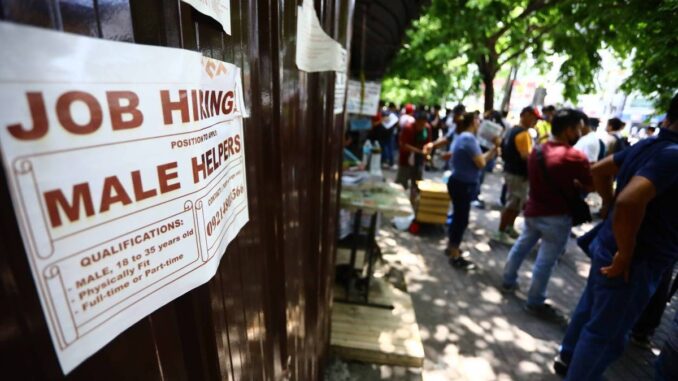
UNEMPLOYMENT may have risen but slowing inflation could lead to improvements in the labor market, GlobalSource Partners analysts said in a commentary released earlier this week.
“The expected decline in the inflation rate may be expected to boost private consumption thus supporting a strong GDP (gross domestic product) performance,” Diwa Guinigundo and Wilhelmina Manalac said in a September 9 report.
“This, in turn, can paint a more positive employment outlook,” they added.
The country’s jobless rate worsened to 4.7 percent in July from 3.1 percent a month earlier, the Philippine Statistics Authority (PSA) reported last week, with an estimated 2.38 million Filipinos said to be without work.
Inflation, meanwhile, was at 4.4 percent in July and eased to 3.3 percent in August.
Guinigundo and Manalac said that while there is normally a negative correlation between inflation and employment, there have also been instances where high inflation and high unemployment coexisted.
A structural factor — the quality of economic growth — could also explain the Philippine labor situation, they added.
“While the 2nd quarter 2024 growth stood at 6.3 percent, it looks like the job-creating impact of higher economic growth was not sustained in the subsequent month,” they said.
They noted that the PSA had cited youth unemployment as one of the reasons behind the higher overall jobless rate and that half a million new graduates had joined the labor force in June.
“On this basis, aside from its structural causes, the rising [unemployment] trend may also be considered seasonal in nature,” Guinigundo and Manalac said.
Evidence of the labor market’s structural aspect can be seen in the underemployment rate, they continued, with the rate having stayed unchanged at 12.1 percent in June from a month earlier while improving from the year-earlier 15.9 percent.
Both noted government efforts to attract investments that will generate high-quality jobs and efforts to finalize the Trabaho Para Sa Bayan (Jobs for the Country) Plan, which will serve as the Philippines’ employment generation master plan.
Innovation initiatives such as upskilling programs and the Konektadong Pinoy bill, in addition, “may very well address some aspects of the structural issues in the country’s quality of economic growth.”
But they criticized the government’s having highlighted that Philippine unemployment was comparable to major Asian economies, saying that “any percentage increase in the unemployment rate means economic disenfranchisement of those who failed to land a job,” Guinigundo stressed.
“The challenge of high incidence of poverty remains in the Philippines.”
The government is targeting 6.0- to 7.0-percent GDP growth for 2024. With inflation having slowed and expected to fall firmly within the 2.0- to 4.0-percent target for the full year, the Bangko Sentral ng Pilipinas has revised its outlook on economic growth to the target being achieved.


Be the first to comment